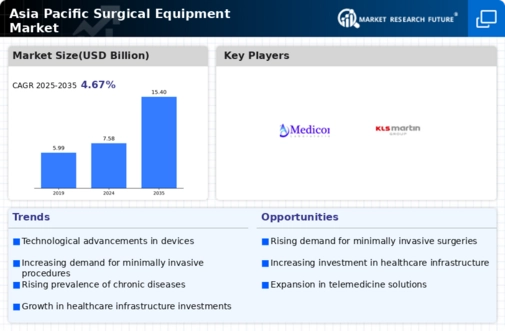Market Analysis
In-depth Analysis of Asia Pacific Surgical Equipment Market Industry Landscape
The Asia Pacific Surgical Equipment Market is a vital component of the healthcare industry, encompassing a wide range of devices and tools used in various surgical procedures. Understanding the market dynamics is crucial for manufacturers and healthcare providers to navigate the diverse and rapidly evolving healthcare landscape in the Asia Pacific region. A growing population coupled with the increasing awareness of healthcare leads to the expansion of the demand in the Asia Pacific region towards the surgical procedures. The market dynamic is greatly shaping the dynamics of healthcare infrastructure and an increase in the availability of medical centers emerge as the conditions. New technologies innovate surgical devices due to the continuous development. It is further associated with the emergence of more refined, effective, and minimally invasive surgical tools allowing surgeons to improve the overall capacities and outcomes of surgical procedures. As in Asia Pacific region, the number of patients suffering from chronic diseases such as cardiovascular and cancer increases, this affects dynamics in a market. Equipment used during surgeries to treat and manage some of these conditions is in high demand, thereby, enhancing the market growth. The dynamics of the market are determined by government investments in medical infrastructure and interventions aimed at strengthening medical services. Policies that are geared towards developing and strengthening the capacity of surgeries, cutting waiting time and improving the convenience of surgical procedures all have a hand in the growth of the surgical equipment market. The market dynamics in certain countries is affected by economic growth of Asia Pacific countries resulting to increased healthcare budgets. However, cost is one of the major factors that cannot be overlooked at this point and hence the manufacturers have to be struck between advanced technologies and cost-effective solutions which would serve various types of health care facilities. The popular factor which influence the market dynamics of surgical equipment are the trend of minimally invasive surgeries. Tools developed for procedures that take place through laparoscopic, robotic-assisted, or endoscopic means have become increasingly popular in connection to the trend away from more invasive surgeries. Local culture and demographic distinctions around the Asia Pacific region influence market dynamics. The adoption of certain surgical techniques and the need for certain types of surgical equipment are influenced by society’s preferences, healthcare practices and population demographics. It is one of the market editorial forces that significantly influence the market’ dynamics in terms of stringent regulatory standards, compliance with health authorities like the china food and drug administration (CFDA) and other regional bodies. The manufacturers must observe to regulations so as to have their products approved and enter the market. The fierce market competition among the manufacturers is one of the roles of globalization. Companies provide product innovation, quality, pricing strategies which are allow influencing market dynamics if they attempt gaining larger percentage of market share in Asia Pacific surgical equipments. Market dynamics depends on the need for qualified healthcare professionals well versed in modern surgical tools. The benefits of increased acceptance rates alongside better utilization of computed surgical tools-training programs and skill development initiatives increase the adoption rates. The target market is segregated according to the different categories of surgical equipment such as the surgical lasers, electrosurgical devices, diagnostic equipment amongst others. The comprehension of these areas is vital to the manufacturers to develop products for different surgical specialties and special needs. The adoption of telemedicine and digital technologies influences market dynamics. Connectivity and integration of surgical equipment with digital platforms contribute to improved communication, remote consultations, and data management in the Asia Pacific surgical landscape.





Leave a Comment